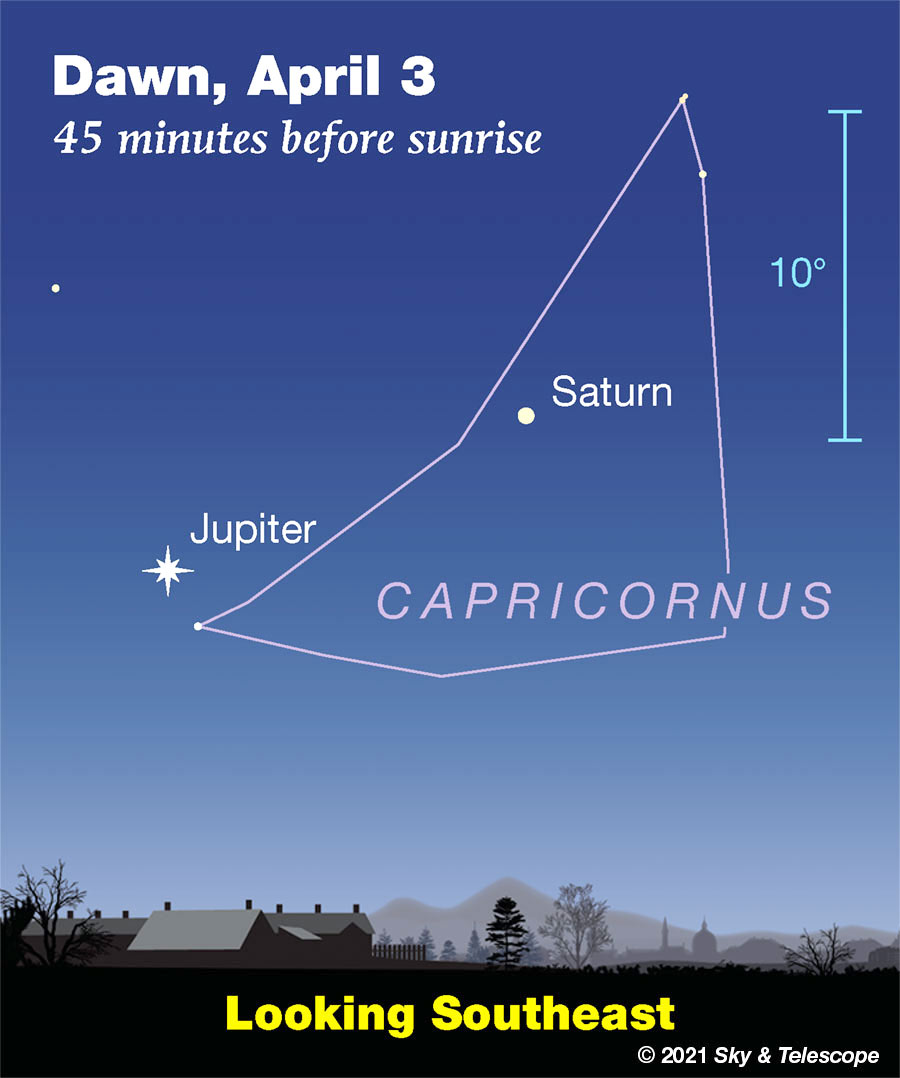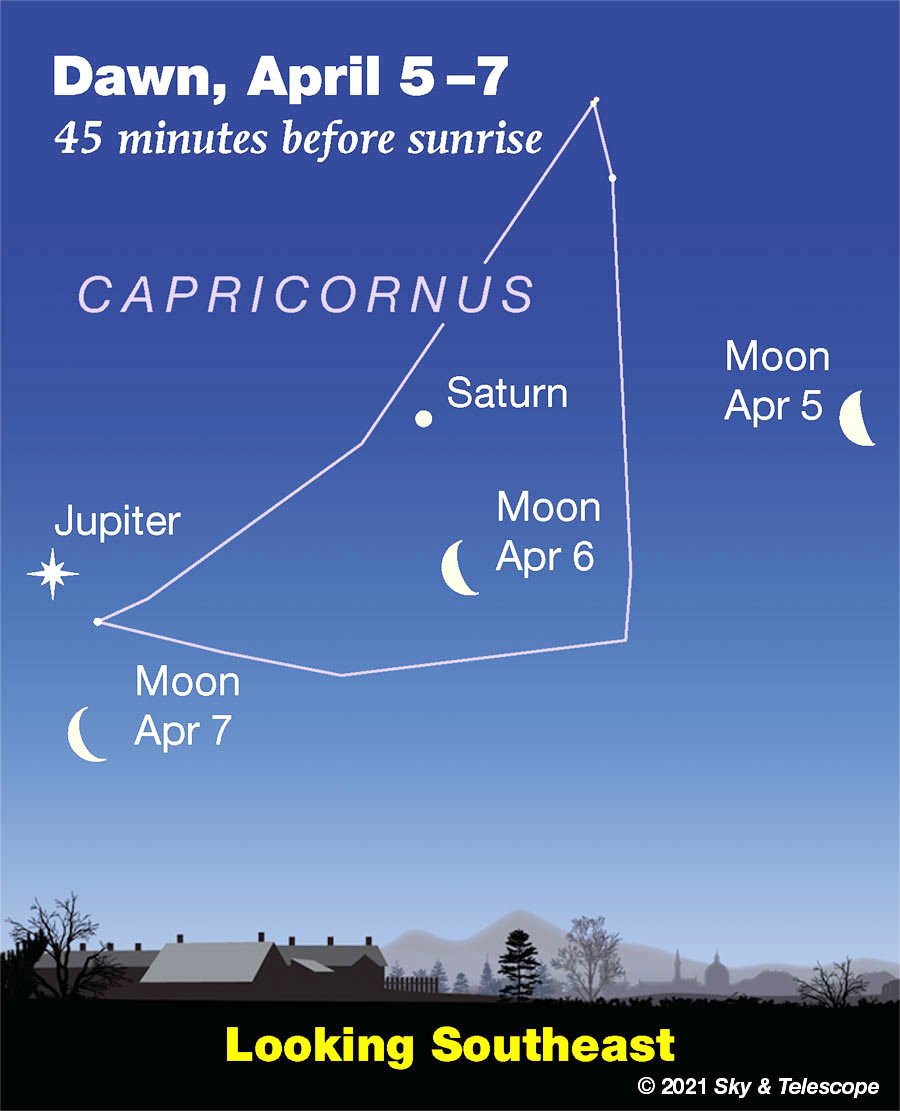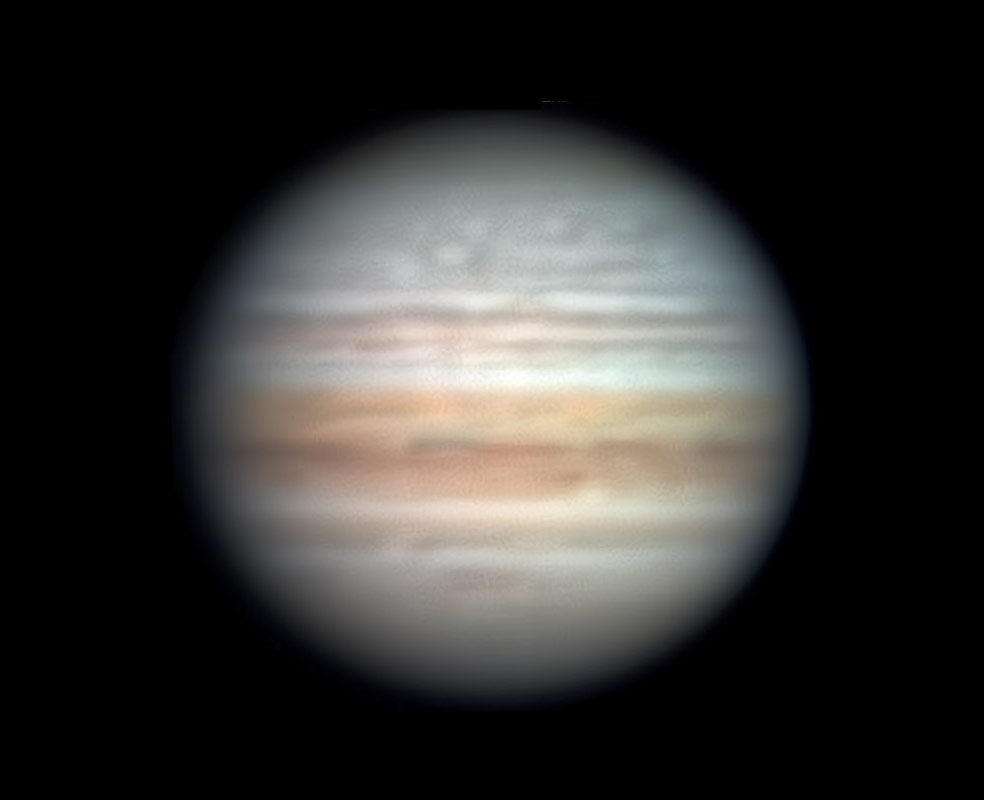8th-magnitude Nova in Cassiopeia. Nova Cassiopeiae 2021, now also known as V1405 Cassiopeiae, was still at about magnitude 8.2 as of April 2nd, after it was discovered at 9.6 on March 18th and quickly peaked at 7.7. For finder charts and more info, see Bright Nova Erupts in Cassiopeia.
To get a light curve with the most up-to-date brightness measurements, go to aavso.org and in "Pick a Star", enter "V1405 Cas" and choose "Plot a light curve". There, visual observers' estimates are the open black circles, and photoelectric V magnitudes are the green squares. (You can see calendar dates instead of Julian Days using "Preferences".)
And where's Cassiopeia itself? Catch it sinking in the north-northwest right after the end of twilight. Look early before it gets too low!
FRIDAY, APRIL 2
■ Shortly after the end of twilight around this time of year, Arcturus, the bright Spring Star climbing in the east, stands just as high as Sirius, the brighter Winter Star descending in the southwest (for skywatchers at mid-northern latitudes).
These are the two brightest stars in the sky at the time. But Capella is a very close runner-up to Arcturus! Spot it high in the northwest.

SATURDAY, APRIL 3
■ The huge, bright Winter Hexagon is still in view early after dark, filling the sky to the southwest and west.
Start with brilliant Sirius in the southwest, the Hexagon's lower left corner. High above Sirius is Procyon. From there look higher upper right for Pollux and Castor (lined up nearly horizontal), lower right from Castor to Menkalinan and then bright Capella, lower left from there to Aldebaran (past Mars), lower left to Rigel at the bottom of Orion, and back to Sirius.
The Hexagon is somewhat distended. But if you draw a line through its middle from Capella to Sirius, the "Hexagon" is fairly symmetric with respect to that axis.
■ Last-quarter Moon tonight (exactly last quarter at 6:02 a.m. Sunday morning EDT). The Moon rises tonight very late, around 2 or 3 a.m. Before dawn on Sunday morning the you'll find it shining at the handle of the Sagittarius Teapot.
SUNDAY, APRIL 4
■ Right after it's fully dark, Sirius shines brilliantly in the south-southwest. Lower left of Sirius, by about one fist, is the triangle of Adhara, Wezen, and Aludra, from right to left. They form Canis Major's hind foot, rear end, and tail, respectively. Or, alternatively, the lower end and handle of the Meat Cleaver.
A little upper left of them, forming a 3rd- and 4th-magnitude arc 7° long, are the three uppermost stars of the constellation Puppis. No, that's not a puppy, despite following right behind the Big Dog. It's the Poop Deck (stern) of the giant ancient constellation Argo Navis, the ship of Jason and the Argonauts. These three are the only stars of Argo that are readily visible naked-eye from mid-northern latitudes.
Just 1.5° upper right of the middle of the three, binoculars on a dark night will show the 6th-magnitude open cluster M93. It's elongated northeast-southwest.
MONDAY, APRIL 5
■ Shortly after the end of twilight around this time of year, Arcturus, the bright Spring Star climbing in the east, stands just as high as Sirius, the brighter Winter Star descending in the southwest (for skywatchers at mid-northern latitudes).
■ Early in Tuesday's dawn the crescent Moon shines under Saturn, as shown below. Then in Wednesday's dawn, the Moon shines under Jupiter.

TUESDAY, APRIL 6
■ The bright star high in the west-northwest during and after dusk is Capella. Its pale-yellow color matches that of the Sun, meaning they're both about the same temperature. But otherwise Capella is very different. It consists of two yellow-giant stars orbiting each other every 104 days.
Moreover, for telescope users, it's accompanied by a distant, tight pair of red dwarfs: Capella H and L, magnitudes 10 and 13. Article and finder charts.
WEDNESDAY, APRIL 7
■ Castor and Pollux shine together nearly overhead in the south after dark. Pollux is slightly the brighter of these "twins." Draw a line from Castor through Pollux, follow it farther out by a big 26° (about 2½ fists at arm's length), and you're at the dim head of Hydra, the Sea Serpent. In a moonless dark sky it's a subtle but distinctive star grouping, about the width of your thumb at arm's length. Binoculars show it easily through light pollution or moonlight.
Continue the line farther by a fist and a half and you hit 2nd-magnitude Alphard, Hydra's orange heart.
Another way to find Hydra's head: It's almost midway from Procyon to Regulus.
THURSDAY, APRIL 8
■ At this time of year, the two Dog Stars stand vertically aligned around the end of twilight. Look southwest. Brilliant Sirius in Canis Major is below, and Procyon in Canis Minor is high above.
FRIDAY, APRIL 9
■ Vega, the bright "Summer Star," rises in the northeast late these evenings. Exactly where should you watch for it to come up? Spot the Big Dipper almost overhead in the northeast. Look at Mizar at the bend of its handle. If you can see Mizar's tiny, close companion Alcor (binoculars show it easily), follow a line from Mizar through Alcor all the way down to the horizon. That's where Vega will make its appearance.
SATURDAY, APRIL 10
■ By late evening the Sickle of Leo stands nearly vertical high in the south. Its bottom star is Regulus, the brightest of Leo. Leo himself is walking westward. The Sickle forms his front leg, chest, mane, and part of his head. Off to the left, a long right triangle forms his hind end and long tail.
This Week's Planet Roundup
Mercury, Venus, and Neptune are out of sight in the glare of the Sun.
Mars (magnitude +1.3, in Taurus) shines high in the west after dark. It's visibly fainter now than than orange Aldebaran below it, not to mention brighter orange Betelgeuse farther to Mars's left. In a telescope Mars is a mere 5 arcseconds wide: a tiny, shimmering bright blob too small for any surface detail.
Jupiter and Saturn have been emerging into dawn view for the last month. Look for them low in the southeast about 60 to 40 minutes before your local sunrise time. Saturn is the higher of the two, but it's much dimmer at magnitude +0.8. Jupiter shines at magnitude –2.1 (those values don't count the atmospheric extinction for objects at low altitudes). Find Jupiter some 12° to Saturn's lower left: roughly a fist at arm's length.

South here is up, celestial west is left. "Oval BA [well above center and a bit left] can be seen just after the central meridian. It is still very pale," he notes. The South Equatorial Belt "looks very strange" with its very narrow dark lines and thin pale center. The Equatorial Zone "has a very strong ochre color" in its central and north parts. "The North Equatorial Belt has a very dark color."
Uranus (magnitude 5.8, in western Aries) sets in the west just after the end of evening twilight.
All descriptions that relate to your horizon — including the words up, down, right, and left — are written for the world's mid-northern latitudes. Descriptions that also depend on longitude (mainly Moon positions) are for North America.
Eastern Daylight Time, EDT, is Universal Time minus 4 hours. Universal Time is also known as UT, UTC, GMT, or Z time. To become more expert about time systems than 99% of the people you'll ever meet, see our article Time and the Amateur Astronomer.
Want to become a better astronomer? Learn your way around the constellations. They're the key to locating everything fainter and deeper to hunt with binoculars or a telescope.
This is an outdoor nature hobby. For an easy-to-use constellation guide covering the whole evening sky, use the big monthly map in the center of each issue of Sky & Telescope, the essential magazine of astronomy.
Once you get a telescope, to put it to good use you'll need a detailed, large-scale sky atlas (set of charts). The basic standard is the Pocket Sky Atlas (in either the original or Jumbo Edition), which shows stars to magnitude 7.6.

Next up is the larger and deeper Sky Atlas 2000.0, plotting stars to magnitude 8.5; nearly three times as many. The next up, once you know your way around, are the even larger Interstellarum atlas (stars to magnitude 9.5) or Uranometria 2000.0 (stars to magnitude 9.75). And be sure to read how to use sky charts with a telescope.
You'll also want a good deep-sky guidebook, such as Sky Atlas 2000.0 Companion by Strong and Sinnott, or the bigger (and illustrated) Night Sky Observer's Guide by Kepple and Sanner.
Can a computerized telescope replace charts? Not for beginners, I don't think, and not on mounts and tripods that are less than top-quality mechanically, meaning heavy and expensive. And as Terence Dickinson and Alan Dyer say in their Backyard Astronomer's Guide, "A full appreciation of the universe cannot come without developing the skills to find things in the sky and understanding how the sky works. This knowledge comes only by spending time under the stars with star maps in hand."
![]() Audio sky tour. Out under the evening sky with your
Audio sky tour. Out under the evening sky with your
earbuds in place, listen to Kelly Beatty's monthly
podcast tour of the heavens above. It's free.
"The dangers of not thinking clearly are much greater now than ever before. It's not that there's something new in our way of thinking, it's that credulous and confused thinking can be much more lethal in ways it was never before."
— Carl Sagan, 1996
"Facts are stubborn things."
— John Adams, 1770
 9
9









Comments
Rod
April 2, 2021 at 10:07 pm
mary beth, New Jersey Eclipse Fan. Lovely evening at my place tonight with temps near 3C. Fields wet in many places though from rain a couple of days ago. However, I did get out tonight for nearly 1.5 hours using my 90-mm refractor telescope at 71/72x views and also 10x50 binoculars. Observed 2000-2120 EDT/0000-0120 UT 03-April-2021. Last Quarter Moon 04-April-2021 at 1002 UT. Some very good views of Mars in Taurus near NGC 1746 about 32' angular separation in sky position. Faint stars visible in Mars FOV using 14-mm at 71/72x views. Mars distinct planetary disk resolved but no surface features visible. The position of Mars tonight in Taurus with NGC 1746 nearby in sky position, would make for a lovely photo. M42 distinct with nebulosity and 4 stars visible in Trapezium. 10x50 binocular views of M42 very good as well as M45, the Pleiades in Taurus. Lovely early spring evening tonight with cool temperatures. Starry Night Sky Calendar View showed Mars and NGC 1746 close in sky position tonight near 2100 EDT. Wikipedia reports NGC 1746 is asterism vs. other sources indicating open cluster.
You must be logged in to post a comment.
mary beth
April 3, 2021 at 10:37 pm
Hi Rod, Happy Easter! Glad field conditions are improving. Here I have been enjoying Spica. We had a huge tree trimmed extensively so Virgo is visible from the yard much sooner than years past. I almost feel like it’s May because I can see it. I have an excellent view of Orion this time of year but I know it won’t last much longer. I read on another blog that the crescent moon will pair nicely with Mars on April 16 and 17th so hoping for clear skies for everyone!
You must be logged in to post a comment.
Rod
April 3, 2021 at 11:10 pm
Same to you mary beth. The info on the Moon with Mars is correct but 0100 UT on 18th April (2100 EDT 17 April), the Moon and M35 open cluster in Gemini are close to 0.5 degrees apart in the sky. That could make for a very nice view using binoculars and telescopes-weather permitting. I was out tonight using my 10-inch but cirrus bands moved in about an hour after I was out viewing. I did get some enjoyable views of Mars again in Taurus. Starry Night Pro Plus 8 shows TYC1849-1522-1 is mv +8.75. At 34/35x, Mars not resolved as planetary disk like last night using the 90-mm refractor at 71-72x views. However, the position of Mars in Taurus made for some lovely viewing with fainter stars all around including NGC 1746 open cluster. Mars and TYC1849-1522-1 angular separation according to Starry Night, 2’ 21”. SIMBAD portal shows TYC1849-1522-1 is known as HD 32828 too. Mv +8.76 and stellar parallax 2.3446 mas. It is a spectral class AO star. Stellar parallax indicates the star ~ 1391 LY distance.
You must be logged in to post a comment.
mary beth
April 5, 2021 at 12:27 pm
I will also mark that on my calendar for the 18th, thank you. I am not at all familiar with the spectral class of stars but I just pulled up some information about it online. Thank you for sharing!
You must be logged in to post a comment.
New Jersey Eclipse Fan
April 6, 2021 at 4:01 pm
As usual, Rod & Mary Beth, I'm late to the (star) party. My wife and I entertained the out-of-town kids & grandkids all week-long during what was both Jewish and Christian Holy Week. Now we need a vacation! I do have a question: Before I go to bed, which can be 2:00am or later, I look out north-facing window and say "good night" to Polaris. Until recently, however, there was a brighter star in the NNW sky that has since disappeared. Any idea what I was looking at? It was closer to the horizon than Polaris. Thanks and keep entertaining and informing with your comments!
You must be logged in to post a comment.
mary beth
April 6, 2021 at 9:07 pm
Hi NJEF!! Sounds like you had your own super star party! Sounds fun! think it was Capella, it makes a fast and tight spin around the pole! Rod what are your thoughts?
You must be logged in to post a comment.
Rod
April 7, 2021 at 9:17 am
NJEF is likely seeing Capella. I used Stellarium 0.21.0 and ran the clock back for Trenton NJ at 0200 local time this morning back to March 29th. Capella is in NNW sky and sinking lower like this morning sky view. Vega and Deneb are in NE sky. However, NJEF could also file an X-Files report too :)---Rod
You must be logged in to post a comment.
mary beth
April 7, 2021 at 7:16 pm
I did the same thing Rod, thanks to you recommending Stellarium. You should get a commission!! i’ve recommended it to a lot of people and they love it to! I am with you on NJEF filing a report!!
You must be logged in to post a comment.
New Jersey Eclipse Fan
April 8, 2021 at 2:14 am
Oh you two are good! Capella makes sense, so need for an X-files report...yet.
You must be logged in to post a comment.
You must be logged in to post a comment.